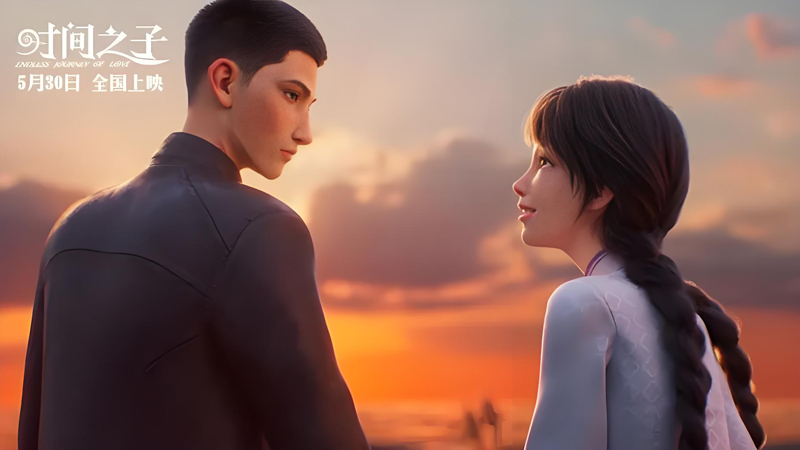The most unexpected magic happens not in fantasy realms, but in animation studios. Yu Ao's (于奥) debut feature, Endless Journey of Love (时间之子) - a visually breathtaking tale of time manipulation and star-crossed love - has quietly become China's most emotionally resonant animated film of 2025, grossing ¥130 million ($18 million) since its release on the Dragon Boat Festival. But what audiences experience as spellbinding cinema began as something far more personal: a journey through grief.
"In 2019, Tienan (铁男) and I faced a loss that reshaped our world," Yu reveals during our conversation in Beijing, her hands cradling a cup of jasmine tea. "We didn't set out to make a blockbuster. We needed to find meaning in goodbye." This raw emotional truth became the foundation for the protagonist, Qianxiao (千晓), and the film's central promise: "to guard one day of love for a lifetime." Test screenings revealed unexpected therapeutic power - teenagers clutching weeping parents, estranged siblings reconnecting after decades of silence.
Yu's artistic vision was forged in Qingdao's theatrical world, where her father worked. Childhood viewings of classics like Lotus Lantern (宝莲灯) (featuring Chen Peisi's legendary voice work) taught her that "true animation magic lives in emotional authenticity, not technical budgets." Now, as the first female director from Qingdao to achieve blockbuster status, she repays her coastal roots through subtle visual poetry - the film's breathtaking oceanic finale perfectly mirrors the city's rugged shoreline, a loving homage only locals might fully appreciate.
The 3,000-Hour Sandcastle
Beneath Endless Journey of Love's ethereal beauty lies an extraordinary technical achievement that redefined animation possibilities. The film's central "Time Wheel" device, which visualizes time as cascading golden particles, became an obsession for Yu's team. "Each grain needed physics, poetry, and emotional weight," explains lead VFX artist Zhang Wei (张伟). The staggering technical requirements - 50+ particle layers per frame, each taking 3-4 hours to render - turned production into what the crew called "building a sandcastle with atomic precision."
Facing Nezha's (哪吒) towering legacy with just 15% of its budget, Yu's team developed revolutionary solutions to industry-wide challenges. As animation veterans fled to gaming studios, they repurposed motion-capture technology from Yu's martial arts film The Thousand Faces Of Dunjia 2 (奇门遁甲2), transforming Zhou Tienan's (周铁男) live-action combat into assassin Shíqī's (十七) breathtaking fight sequences - imagine John Wick's (疾速追杀) precision meeting traditional ink-wash painting's fluid elegance. "Constraints became our creative partners," Yu reflects. "When you can't buy solutions, you invent them."
The film's most unexpected secret weapon? Homemade shrimp paste. When Yu needed voices, she bypassed agents for handwritten letters to fellow Qingdao artists. Superstar Huang Bo (黄渤) responded immediately: "Send the script, keep your checkbook." His payment? A jar of Yu's family-fermented shrimp sauce, returning a kindness from years past. This "brine-based diplomacy" attracted an all-star cast who worked with unprecedented passion - pop icon Wang Junkai (王俊凯) spent nights perfecting his assassin's breathing patterns, while ethereal-voiced Zhou Shen recorded between midnight concerts.
Now, Yu channels this community spirit into Qingdao's burgeoning animation scene through her Creative Collective, where emerging talents learn that "great animation, like great shrimp paste, needs time, patience, and local ingredients." As golden sunlight dances on Jiaozhou Bay - mirroring her film's signature visuals - Yu shares her philosophy: "Our golden particles weren't just effects. They carried the weight of real human moments, preserved against time's flow."
The Ripple Effect
The true revolution of Endless Journey of Love lies beyond its technical wizardry. In the months following its release, Yu Ao’s "emotional-first" approach sparked what industry analysts now call "The Ao Effect" - a seismic shift where three major studios have greenlit projects prioritizing intimate human stories over spectacle. At Qingdao’s newly opened Animation Resonance Institute, Yu personally oversees twelve emerging filmmakers crafting stories ranging from migrant worker narratives to dementia-themed fantasies. "We’re building an ecosystem," she explains, walking past walls adorned with golden particle concept art. "Where technology serves emotion, not vice versa."
The legendary shrimp sauce that catalyzed the film's voice-acting revolution now symbolizes this philosophy. Huang Bo’s original jar occupies a display case at the Qingdao Film Museum beside storyboards showing the "Time Wheel’s" evolution. "Visitors sometimes ask if the sauce was CGI," Yu laughs, her eyes crinkling. "But its power came from authenticity - like when Wang Junkai spent three nights perfecting how an assassin breathes when remembering lost love."
Yu Ao’s legacy crystallizes in a single truth: In animation, the most powerful special effect is humanity itself. Where Nezha (2019) triumphed through mythological grandeur, Endless Journey of Love conquered hearts by transforming personal grief into universal solace. Those painstakingly crafted golden sands (3 hours per frame!) now symbolize cinema’s highest calling - to preserve fragile human moments against time’s erasure.



